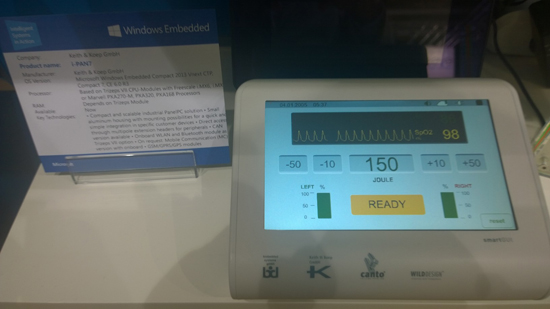On stage at Embedded World: Windows Embedded
The i-PAN7 by Keith & Koep GmbH, a compact and scalable industrial panel PC solution based on Windows Embedded Compact 2013.
Posted By Partha Srinivasan
Senior Product Manager
Last week, during a presentation session at Embedded World 2014 in Nuremberg, Germany, we provided more details on the upcoming update release of Windows Embedded Compact 2013.
In the presentation titled “Windows Embedded Compact 2013: A small devices OS in the World of Intelligent Systems,” I discussed Microsoft’s vision for intelligent systems and the factors contributing to their growth. The small-footprint devices that represent a significant portion of all intelligent industry devices have unique requirements, such as low power needs, low resource requirements such as RAM/ROM, and multiple connectivity options (including local connectivity such as Ethernet and USB, as well as Internet connectivity). These devices also need to have the ability to easily connect to the cloud while ensuring that they are secure and work well with other devices. Microsoft’s solution to address these small-footprint devices is through Windows Embedded Compact, with better power management, the ability to run on a very small footprint and with low RAM, improved connectivity and networking features, and seamless connectivity to the cloud.
I also provided details about the improvements we made to the Windows Embedded Compact platform, including the state-of-the-art tools in Visual Studio 2013, an inbox Wi-Fi device driver for TI chipset, the growing list of BSPs from our partners, and other improvements such as improved kernel debugging over Ethernet and Remote NDIS, serial debugging and more. This release is indicative of our continued effort to improve the platform, as well as making the right investments for our Compact customers.
We also demonstrated an industry HMI panel in a car automation factory, in which the factory worker uses the HMI panel to perform activities such as getting access into the system to perform visual inspection, followed by installing the car components and performing a diagnostics test to ensure proper installation. This demonstration shows how the HMI panel — powered by Windows Embedded Compact 2013 and using the XAML technology used to create a modern-looking application — works seamlessly with other devices such as scanners, RFID readers and temperature sensors to improve the worker’s productivity. This device can further capture the work completion and environment data, which can potentially be analyzed using a management console to improve worker productivity, incorporating new training programs that enable a truly intelligent factory automation system.
In another demonstration, we showed how a server appliance, powered by Windows Server 2012 R2 for Embedded Systems and Microsoft SQL Server 2014 CTP2 for Embedded Systems, and Windows Embedded 8.1 Industry can work seamlessly together in a retail intelligent system scenario. Here, the server appliance is used to manage the POS and kiosk devices in the store, along with the store video surveillance system. The data collected is then forwarded to the cloud and used for predictive analytics to introduce marketing campaigns, better store management, and more. In this intelligent system, the server appliance serves as an information gateway that protects the on-premises data, meeting industry compliance needs while sending the data to the back-end systems in the cloud for aggregation and analysis to improve business intelligence and operational excellence.
Our presentation and two intelligent system demos really illustrated how Microsoft and Windows Embedded technologies can address a range of devices, including the large- and small-footprint industry devices that can help organizations utilize data to make informed decisions and ultimately transform their operations. Read more about Microsoft’s platforms for devices and services for intelligent systems here.
